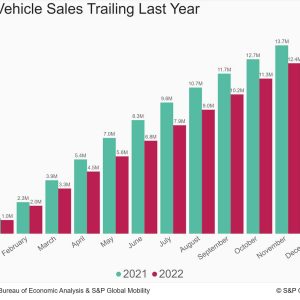
S&P Global Mobility: November auto sales continue previous three-month trend
Ongoing financial headwinds imply no news could be great news
regarding automobile demand levelsWith volume for the month projected at 1.122 million systems,
November U.S. vehicle sales are estimated to equate to an approximated
sales speed of 14.1 million units (seasonally changed annual rate:
SAAR). This would represent a continual enhancement from the May
through September period but will show a decrease from Octobers.
14.9 million-unit speed, according to S&P Global Mobility.
analysis.The daily selling rate metric in November (approximately 44-45K.
per day) would be in-line with levels since September. Translation:.
From a non-seasonally adjusted volume perspective, automobile sales.
continue to plug along at a constant speed.” Sales ought to continue to enhance, given the anticipated continual,.
but moderate, development in general production and stock levels,”.
stated Chris Hopson, principal analyst at S&P Global Mobility.
” However, we also continue to keep an eye on for signals of.
faster-than-expected growth in inventory. Currently, there are no.
clear indications; inventories have advanced as expected. Any.
indication of faster than projected development in the overall stock of.
brand-new vehicles might imply that auto consumers are feeling the.
pressure of the present economic headwinds and pulling away from the.
market.” As an outcome, Octobers SAAR increase is likely to be an anomaly.
compared to the rest of the year, Hopson stated, including that.
there are expectations of volatility in the month-to-month results.
starting in early 2023. Market share of battery-electric vehicles is anticipated to reach.
5.9% in November. Nevertheless, beyond the big coastal cities,.
retail registrations of EVs have yet to take hold, according to.
analysis from S&P Global Mobility.The top-eight EV markets in the US are all in seaside states and.
represent 50.5% of overall EV registrations so far in 2022 (through.
August). The greater Los Angeles and San Francisco metropolitan.
areas alone account for almost one-third of overall share of the US.
EV market. The Heartland states market share of EV sales.
is hardly half of what they contribute to general car.
registrations.” BEV market share control on the 2 coasts is attributed to.
their greater mix of early adopters compared to purchasers in middle.
America,” stated Tom Libby, associate director of Loyalty Solutions.
and Industry Analysis at S&P Global Mobility. “Their.
group profile is more in sync with the conventional BEV purchaser.
than the middle-American profile.” But Libby sees potential for EV acceptance in leading heartland.
markets: “More approval and much wider customer awareness is.
resulting in a natural development of adoption from the coasts to.
the Heartland.” (For more on this analysis of EVs in the Heartland,.
please see.
this special report.) Supporting the EV improvement, item exposes surrounding the.
Los Angeles Auto Show recently continue to show the OEM.
focus.According to Stephanie Brinley, associate director of.
AutoIntelligence at S&P Global Mobility, “As auto programs at.
their best emphasize what people will be driving in coming years,.
the reveals during the Los Angeles Auto Show reflect the continuing.
push towards electric and energized vehicles.” Of note, Fiat announced it will bring a variation of the European.
500 EV to the U.S. starting in early 2024, restoring the 500e.
nameplate. Toyotas reveal of the 2023 Prius hybrid included a.
Prime cut that will double the hatchbacks EV-only variety, while.
the automaker likewise revealed a rendering of the bZ (” Beyond Zero”).
electric-vehicle concept, previewing a forthcoming compact SUV.
Vietnamese entrant VinFast revealed U.S.-trim versions of.
2 EV crossover additions to its lineup – bringing its capacity.
United States offerings to 4.
This short article was published by S&P Global Mobility and not by S&P Global Ratings, which is an individually managed department of S&P Global.
Leave a reply